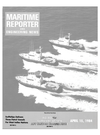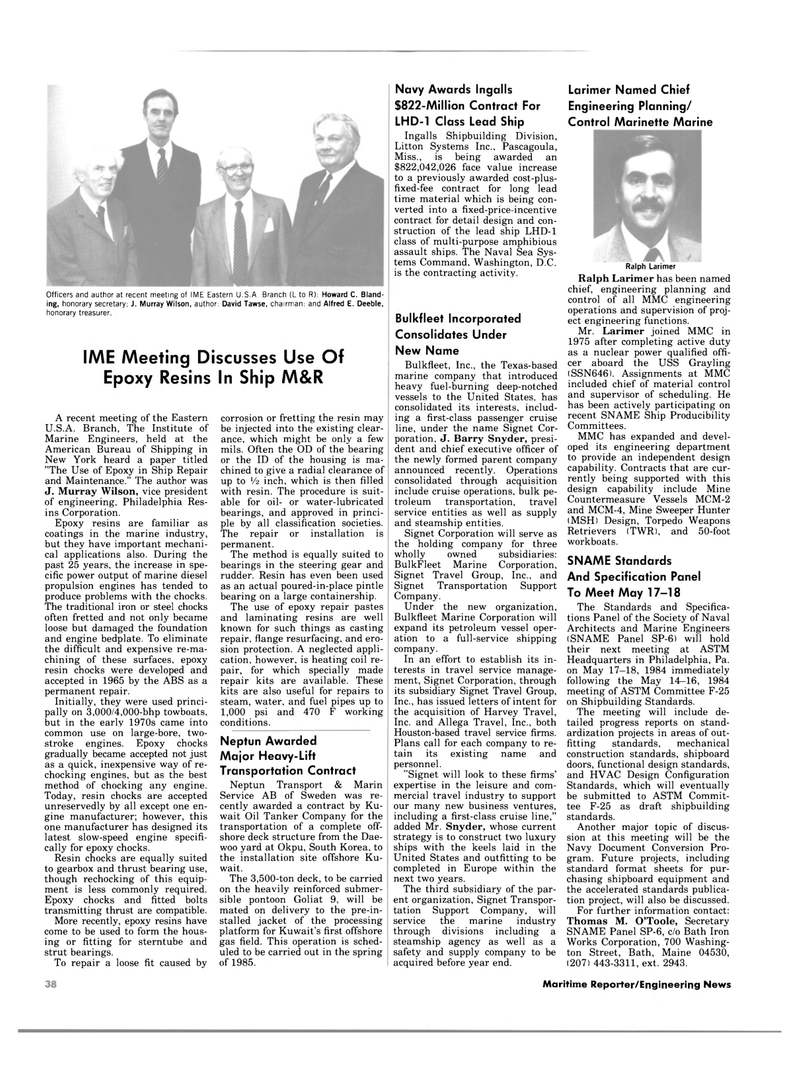
Page 36: of Maritime Reporter Magazine (April 15, 1984)
Read this page in Pdf, Flash or Html5 edition of April 15, 1984 Maritime Reporter Magazine
Officers and author at recent meeting of IME Eastern U.S.A. Branch (L to R): Howard C. Bland- ing, honorary secretary; J. Murray Wilson, author: David Tawse, chairman; and Alfred E. Deeble, honorary treasurer.
IME Meeting Discusses Use Of
In Ship M&R corrosion or fretting the resin may be injected into the existing clear- ance, which might be only a few mils. Often the OD of the bearing or the ID of the housing is ma- chined to give a radial clearance of up to V-2 inch, which is then filled with resin. The procedure is suit- able for oil- or water-lubricated bearings, and approved in princi- ple by all classification societies.
The repair or installation is permanent.
The method is equally suited to bearings in the steering gear and rudder. Resin has even been used as an actual poured-in-place pintle bearing on a large containership.
The use of epoxy repair pastes and laminating resins are well known for such things as casting repair, flange resurfacing, and ero- sion protection. A neglected appli- cation, however, is heating coil re- pair, for which specially made repair kits are available. These kits are also useful for repairs to steam, water, and fuel pipes up to 1,000 psi and 470 F working conditions.
Neptun Awarded
Major Heavy-Lift
Transportation Contract
Neptun Transport & Marin
Service AB of Sweden was re- cently awarded a contract by Ku- wait Oil Tanker Company for the transportation of a complete off- shore deck structure from the Dae- woo yard at Okpu, South Korea, to the installation site offshore Ku- wait.
The 3,500-ton deck, to be carried on the heavily reinforced submer- sible pontoon Goliat 9, will be mated on delivery to the pre-in- stalled jacket of the processing platform for Kuwait's first offshore gas field. This operation is sched- uled to be carried out in the spring of 1985.
Navy Awards Ingalls $822-Million Contract For
LHD-1 Class Lead Ship
Ingalls Shipbuilding Division,
Litton Systems Inc., Pascagoula,
Miss., is being awarded an $822,042,026 face value increase to a previously awarded cost-plus- fixed-fee contract for long lead time material which is being con- verted into a fixed-price-incentive contract for detail design and con- struction of the lead ship LHD-1 class of multi-purpose amphibious assault ships. The Naval Sea Sys- tems Command, Washington, D.C. is the contracting activity.
Bulkfleet Incorporated
Consolidates Under
New Name
Bulkfleet, Inc., the Texas-based marine company that introduced heavy fuel-burning deep-notched vessels to the United States, has consolidated its interests, includ- ing a first-class passenger cruise line, under the name Signet Cor- poration, J. Barry Snyder, presi- dent and chief executive officer of the newly formed parent company announced recently. Operations consolidated through acquisition include cruise operations, bulk pe- troleum transportation, travel service entities as well as supply and steamship entities.
Signet Corporation will serve as the holding company for three wholly owned subsidiaries:
BulkFleet Marine Corporation,
Signet Travel Group, Inc., and
Signet Transportation Support
Company.
Under the new organization,
Bulkfleet Marine Corporation will expand its petroleum vessel oper- ation to a full-service shipping company.
In an effort to establish its in- terests in travel service manage- ment, Signet Corporation, through its subsidiary Signet Travel Group,
Inc., has issued letters of intent for the acquisition of Harvey Travel,
Inc. and Allega Travel, Inc., both
Houston-based travel service firms.
Plans call for each company to re- tain its existing name and personnel. "Signet will look to these firms' expertise in the leisure and com- mercial travel industry to support our many new business ventures, including a first-class cruise line," added Mr. Snyder, whose current strategy is to construct two luxury ships with the keels laid in the
United States and outfitting to be completed in Europe within the next two years.
The third subsidiary of the par- ent organization, Signet Transpor- tation Support Company, will service the marine industry through divisions including a steamship agency as well as a safety and supply company to be acquired before year end. 38 Maritime Reporter/Engineering News
Epoxy Resins
A recent meeting of the Eastern
U.S.A. Branch, The Institute of
Marine Engineers, held at the
American Bureau of Shipping in
New York heard a paper titled "The Use of Epoxy in Ship Repair and Maintenance." The author was
J. Murray Wilson, vice president of engineering, Philadelphia Res- ins Corporation.
Epoxy resins are familiar as coatings in the marine industry, but they have important mechani- cal applications also. During the past 25 years, the increase in spe- cific power output of marine diesel propulsion engines has tended to produce problems with the chocks.
The traditional iron or steel chocks often fretted and not only became loose but damaged the foundation and engine bedplate. To eliminate the difficult and expensive re-ma- chining of these surfaces, epoxy resin chocks were developed and accepted in 1965 by the ABS as a permanent repair.
Initially, they were used princi- pally on 3,000/4,000-bhp towboats. but in the early 1970s came into common use on large-bore, two- stroke engines. Epoxy chocks gradually became accepted not just as a quick, inexpensive way of re- chocking engines, but as the best method of chocking any engine.
Today, resin chocks are accepted unreservedly by all except one en- gine manufacturer; however, this one manufacturer has designed its latest slow-speed engine specifi- cally for epoxy chocks.
Resin chocks are equally suited to gearbox and thrust bearing use, though rechocking of this equip- ment is less commonly required.
Epoxy chocks and fitted bolts transmitting thrust are compatible.
More recently, epoxy resins have come to be used to form the hous- ing or fitting for sterntube and strut bearings.
To repair a loose fit caused by
Larimer Named Chief
Engineering Planning/
Control Marinette Marine
Ralph Larimer
Ralph Larimer has been named chief, engineering planning and control of all MMC engineering operations and supervision of proj- ect engineering functions.
Mr. Larimer joined MMC in 1975 after completing active duty as a nuclear power qualified offi- cer aboard the USS Grayling (SSN646). Assignments at MMC included chief of material control and supervisor of scheduling. He has been actively participating on recent SNAME Ship Producibility
Committees.
MMC has expanded and devel- oped its engineering department to provide an independent design capability. Contracts that are cur- rently being supported with this design capability include Mine
Countermeasure Vessels MCM-2 and MCM-4, Mine Sweeper Hunter (MSH) Design, Torpedo Weapons
Retrievers (TWR), and 50-foot workboats.
SNAME Standards
And Specification Panel
To Meet May 17-18
The Standards and Specifica- tions Panel of the Society of Naval
Architects and Marine Engineers (SNAME Panel SP-6) will hold their next meeting at ASTM
Headquarters in Philadelphia, Pa. on May 17-18, 1984 immediately following the May 14-16, 1984 meeting of ASTM Committee F-25 on Shipbuilding Standards.
The meeting will include de- tailed progress reports on stand- ardization projects in areas of out- fitting standards, mechanical construction standards, shipboard doors, functional design standards, and HVAC Design Configuration
Standards, which will eventually be submitted to ASTM Commit- tee F-25 as draft shipbuilding standards.
Another major topic of discus- sion at this meeting will be the
Navy Document Conversion Pro- gram. Future projects, including standard format sheets for pur- chasing shipboard equipment and the accelerated standards publica- tion project, will also be discussed.
For further information contact:
Thomas M. O'Toole, Secretary
SNAME Panel SP-6, c/o Bath Iron
Works Corporation, 700 Washing- ton Street, Bath, Maine 04530, (207) 443-3311, ext. 2943.

 35
35

 37
37
